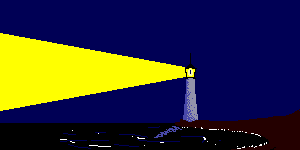One of our favorite things to see & do is visit lighthouses no matter where we visit. So with over 63 lighthouses and buildings you can only imagine our excitement ~ did we get to see them all ~ no but we did see a lot of them. Out of the 63 there are still over 40 still active. Prince Edward Island, one of Canada's four Atlantic Provinces, is the smallest of the ten provinces in both size and population. The island is crescent shaped, measures 139 miles from tip to tip, is 4 to 40 miles wide and it's total area is 2,185 square miles. It is situated in the Gulf of St. Lawrence and is separated from Nova Scotia and New Brunswick by the Northumberland Strait. The province has numerous lakes and rivers, most of which are quite small, and is known for its red soil, sand dunes and 500 miles of beaches. The highest point is 499 feet above sea level at Springton, Queen's County.

For centuries, lighthouses have been symbols of hope, safety and refuge. Nowhere is their presence more valued than on Prince Edward Island. Although it is only 139 miles long from North Cape to East Point, the undulating coastline stretches for 500 miles. Strategically located along the sandy beaches, or standing sentinel atop high red cliffs, there are approximately forty-five beacons/lighthouses still guiding mariners away from dangerous reefs and into safe harbours.
During the 19th Century, the Island's waters were very busy. Thousands of immigrants arrived by ship and farm produce & lumber were exported. Shipbuilding became a booming industry with hundreds of sailing vessels being launched from PEI, destined for all parts of the world. Fishing vessels from Europe and the United States fished the rich waters surrounding the Island. With all the activity, it was inevitable that numerous shipwrecks occurred with loss of lives and cargoes. At present there are seven lighthouses on Prince Edward Island open to the public. Visitors can climb right into their Lantern Rooms to view the working light. Four are museums having collections of lighthouse-related artifacts.
Point Prim Lighthouse
The first lighthouse built on Prince Edward Island in 1845. Architect Isaac Smith designed the 60 foot round brick lighthouse that is one of the last of its kind in Canada.
 |
| Point Prim Lighthouse |
Leard's Front & Back Range Light
Victoria Harbor was one of the Island’s busiest seaports in the days of sail. It is now mainly a tourism destination. The Front range light was built in 1879 and the back range light was built in 1901 but closed in around 1913. The back light sits on private property now and the front light is maintained by the city of Victoria by the Sea.
 |
| Leard's Front Range Light ~ Steps to top light ~ Going into top ~ Leard's Back Range Light |
Cape Bear Lighthouse
Cape Bear is located on the southeastern tip of Prince
Edward Island. The coast consists of generally rugged red sandstone cliffs and
small secluded beaches. Its high banks offer a good location for viewing seals.
 |
| Cape Bear Lighthouse ~ first to hear SOS from Titanic ~ See Ralph in Light |
The first Canadian land station to
hear the SOS of the Titanic as she sank in 1912 was the Marconi station at Cape
Bear. The station is no longer there, but the Cape Bear Lighthouse is still
there and has been in existence since 1881. The lighthouse is a square three
story tower with a warning beacon on top. It has gabled windows at each level,
on three sides of the structure. The light is 23 metres above the water, while
the tower itself stands at 12 metres.
During the Second World War, the
lighthouse proved useful for spotting German U-boats that neared the coast.
Several were seen along the shore, but disappeared while being tracked. They
probably vanished into the deep trench which runs between the Magdalen Islands
and Prince Edward Island.
Port Borden Pier Light
The hexagonal pyramidal wooden tower has a square lantern and a hexagonal gallery. It is shingled and painted white with red trim. The gallery is supported by wooden brackets. The windows and door have pedimented caps. Built in 1919 same year as the two range lights. It is on the end of the former ferry pier and for many years guided the car ferries into the harbor. The pier has been purchased by a fish packing company that has built a factory there so access to the lighthouse is restricted.
The two range lights were decommissioned in June, 1997, when the Confederation Bridge was opened, but the pier lighthouse has remained an active light, providing guidance for the fishing boats and other marine traffic.
 |
| Port Borden Pier Lighthouse ~ Port Borden Front Range Light ~ Port Borden Rear Range Light |
North Rustico Lighthouse
Built in 1876 the tower is a simple, well-proportioned structure with an attached dwelling. Unlike most lighthouses on PEI, which are shingled, it is covered with metal siding. The lantern has a wooden balustrade and is supported by wooden brackets. The lighthouse was designed by the Department of Marine. The builder is unknown. The design of the building was carefully planned as can be seen by the placement of the windows. The dwelling has two windows on each of the long facades and one on the tower end. The tower windows on the long façade align vertically with the corresponding dwelling windows.
 |
| Town of North Rustico ~ North Rustico Lighthouse ~ Lighthouse Beacon ~ Dirt road from Lighthouse |
Covehead Lighthouse
Built in 1967 ~ The first Covehead Lighthouse was located at Red Point. It was a three-sided structure. The experimental form always looked crooked. In 1975 the site was moved due to erosion, and a new square tapered lighthouse was built. It has always been fully automated and is considered a landfall light. The lighthouse was renovated in 1994 due to rotting and is now covered with pressure treated cedar siding. There is a plaque on the side of the lighthouse describing the Yankee Gale, remembering the eighty ships and 161 men who perished in the savage 1851 storm.
 |
| Covehead Lighthouse |
We could not have seen all the Lighthouse/Range lights but we sure saw a lot of them ~ Tomorrow I will show you the reat of them. Some of them we couldn't climb up to the top but we did get to enjoy seeing them. If you love Lighthouses this is a great place to see them.
Have Fun & Travel Safe



 Also the world renowned Bluenose II Sailing Vessel is located here in Lunenburg ~ Bluenose II is a replica of the fishing schooner Bluenose which was built in 1963 as a promotional yacht for Oland Brewery and became Nova Scotia's sailing ambassador in 1971. It is being refurbished and should be ready soon to sail the seas once again.
Also the world renowned Bluenose II Sailing Vessel is located here in Lunenburg ~ Bluenose II is a replica of the fishing schooner Bluenose which was built in 1963 as a promotional yacht for Oland Brewery and became Nova Scotia's sailing ambassador in 1971. It is being refurbished and should be ready soon to sail the seas once again.




















































